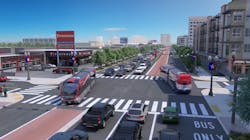VIA Metropolitan gains environmental clearance of ART North/South Corridor Project
VIA Metropolitan Transit’s Advanced Rapid Transit (ART) North/South Corridor Project has been cleared to proceed with final design and construction after gaining federal approval on its environmental evaluation under the National Environmental Policy Act of 1969.
VIA Metropolitan says the Federal Transit Administration (FTA) has applied a categorical exclusion to the project, which means the construction and operation of the transit corridor would have minimal impact and no adverse effect on its surroundings. FTA’s review of the environmental documentation submitted determined the project has “the potential to encounter archaeological resources during construction.” To handle this potential situation, FTA and VIA Metropolitan developed a Construction Monitoring and Inadvertent Discovery Plan.
The ART North/South Corridor Project will operate as the VIA Rapid Green Line and is described by VIA Metropolitan as a first-of-its-kind project in San Antonio and Bexar County. It is designed to move people faster and farther. The North/South project will operate along a 12-mile corridor between San Antonio International Airport through downtown San Antonio to Steves Avenue near Mission Concepcion.
The project will procure 17 new low or no emission buses that will operate in dedicated lanes, curbside business access transit lanes and mixed traffic. The corridor’s 26 stations will feature off-board fare collection, next bus messaging, bike parking and safety enhancements.
The estimated $386.4 million project is part of the FTA’s Capital Investment Grants Program, with VIA Metropolitan asking the federal share of the project costs to be under 50 percent. Approximately 17.5 percent of the project costs will be covered by funds generated from the Keep San Antonio Moving (KSAM) Plan, which was approved by voters in 2020.
“This is a major milestone in the journey to deliver on our commitment to this community, which said yes to investing in transit improvements,” said VIA President and CEO Jeffrey C. Arndt. “I’m proud of the team and the work done to ensure we proceed with a project designed to minimize environmental impact and provide new, modern options to connect more people to opportunity.”
The San Antonio area is experiencing explosive growth, with an additional 1 million residents expected to move to the city by 2040. This growth is expected to also generate an additional 800,000 jobs, as well as more than 1 million new vehicles and an anticipated 82 percent increase in travel time.
For VIA Metropolitan riders, this growth comes with potential to access new jobs, but without a frequent reliable transit network, they could be left out of the positive impacts of this growth. VIA says 60 percent of its riders use VIA service to get to work, 58 percent do not have a motor vehicle in the household and 67 percent live below the federal poverty line.
The KSAM Plan is designed to ensure VIA Metropolitan’s riders see improved physical mobility, as well as economic mobility. Key destinations along the Green Line includes San Antonio International Airport, North Star Mall, Park North Shopping Center, San Pedro Springs Park, San Antonio College, VIA Metro Center, Baptist Medical Center, downtown San Antonio, G.W. Brackenridge High School, Roosevelt Park, Missions National Historic Park, several H-E-B grocery stores and numerous high-density commercial and residential areas.
VIA expects to begin operating the Green Line in 2027. A proposed second corridor would connect the East and West sides. VIA is currently in the process of identifying improvements and funding sources to complete the project.
About the Author

Mischa Wanek-Libman
Group Editorial Director
Mischa Wanek-Libman is director of communications with Transdev North America. She has more than 20 years of experience working in the transportation industry covering construction projects, engineering challenges, transit and rail operations and best practices.
Wanek-Libman has held top editorial positions at freight rail and public transportation business-to-business publications including as editor-in-chief and editorial director of Mass Transit from 2018-2024. She has been recognized for editorial excellence through her individual work, as well as for collaborative content.
She is an active member of the American Public Transportation Association's Marketing and Communications Committee and served 14 years as a Board Observer on the National Railroad Construction and Maintenance Association (NRC) Board of Directors.
She is a graduate of Drake University in Des Moines, Iowa, where she earned a Bachelor of Arts degree in Journalism and Mass Communication.
